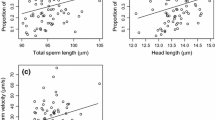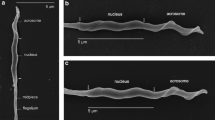Abstract
It is well documented that sperm size and structure varies considerably among avian species, but we know much less about the extent of intraspecific variation in sperm morphometry and its possible co-variation with somatic traits like body size and condition. Here, we investigate patterns of sperm length variation and co-variation in a population of House Wrens (Troglodytes aedon). Total sperm length showed considerable between-male variation, with high repeatability between seasons indicative of a strong genetic basis for this trait. However, we also detected a seasonal increase in the flagellum:head length ratio, which might indicate phenotypic plasticity or adjustment in the relative size of sperm components. The variation in total sperm length within an ejaculate sample was higher for males sampled very early in the season, which may reflect more heterogeneity in the size of seminiferous tubules when testes are growing. None of the studied sperm morphometry traits correlated significantly with any measures of male body size or physiological condition. Further studies are needed to reveal if the observed individual variation in sperm morphology plays any functional or adaptive role.
Zusammenfassung
Variation in der Spermienlänge von Hauszaunkönigen ( Troglodytes aedon )
Obwohl sehr viel über die Variation in Spermiengröße und –struktur zwischen Vogelarten bekannt ist, wissen wir verhältnismäßig weniger über innerartliche Variation in der Morphologie von Spermien sowie über die mögliche Kovarianz zwischen Körpergröße und Kondition. Hier untersuchen wir Muster in der Variation und Kovarianz von Spermienlänge in Hauszaunkönigen (Troglodytes aedon). Wir fanden relative viel Variation in der Spermienlänge zwischen Männchen, wobei eine hohe Ähnlichkeit zwischen Jahren auf eine mögliche genetische Basis hinweist. Wir haben außerdem eine Zunahme des Verhältnisses von Flagellum zu Kopf über die Saison hinweg beobachten können, was möglicherweise auf phänotypische Plastizität in der relativen Größe von verschiedenen morphologischen Komponenten von Spermien hinweist. Die Variation in absoluter Spermienlänge innerhalb einer Ejakulatprobe war höher für Männchen die früh in der Saison beprobt wurden, was möglicherweise auf mehr Heterogenität in der Größe der Hodenkanälchen während der Wachstumsphase der Hoden hinweist. Keine der untersuchten morphologischen Merkmale der Spermien korrelierte statistisch signifikant mit der Körpergröße oder der physiologischen Kondition der Männchen. Weitere Untersuchungen sind notwendig um herauszufinden ob die hier beschrieben Variation in der Morphologie von Spermien wichtig für Funktion und Adaptation ist.


Similar content being viewed by others
References
Aire TA (2007a) Anatomy of the testis and male reproductive tract. In: Jamieson BGM (ed) Reproductive biology and phylogeny of birds, vol 6A. Science Publishers, Enfield, New Hampshire, pp 37–114
Aire TA (2007b) Spermatogenesis and testicular cycles. In: Jamieson BGM (ed) Reproductive biology and phylogeny of birds, vol 6A. Science Publishers, Enfield, New Hampshire, pp 279–347
Benjamini Y, Hochberg Y (1995) Controlling the false discovery rate: a practical and powerful approach to multiple testing. J Roy Stat Soc B 57:289–300
Birkhead TR, Pizzari T (2002) Postcopulatory sexual selection. Nat Rev 3:262–273
Birkhead TR, Pellatt EJ, Brekke P, Yeates R, Castillo-Juarez H (2005) Genetic effects on sperm design in the zebra finch. Nature 434:383–387
Briskie JV, Montgomerie R, Birkhead TR (1997) The evolution of sperm size in birds. Evolution 51:937–945
Burness G, Schulte-Hostedde AI, Montgomerie R (2008) Body condition influences sperm energetics in lake whitefish (Coregonus clupeaformis). Can J Fish Aquat Sci 65:615–620
Calhim S, Birkhead T (2007) Testes size in birds: quality versus quantity–assumptions, errors, and estimates. Behav Ecol 18:271–275
Calhim S, Immler S, Birkhead TR (2007) Postcopulatory sexual selection is associated with reduced variation in sperm morphology. PLoS One 2(5):e413
Cardullo RA, Baltz JM (1991) Metabolic regulation in mammalian sperm: mitochondrial volume determines sperm length and flagellar beat frequency. Cell Motil Cytoskel 19:180–188
Cohen J (1967) Correlation between sperm “redundancy” and chiasma frequency. Nature 215:862–863
Dewsbury DA (1982) Ejaculate cost and male choice. Am Nat 119:601–610
Froman DP, Kirby JD (2005) Sperm mobility: phenotype in roosters (Gallus domesticus) determined by mitochondrial function. Biol Reprod 72:562–567
Froman DP, Pizzari T, Feltmann AJ, Castillo-Juarez H, Birkhead TR (2002) Sperm mobility: mechanisms of fertilizing efficiency, genetic variation and phenotypic relationship with male status in the domestic fowl, Gallus gallus domesticus. Proc R Soc Lond B 269:607–612
García-Berthou E (2001) On the misuse of residuals in ecology: testing regression residuals versus the analysis of covariance. J Anim Ecol 70:708–711
Helfenstein F, Szep T, Nagy Z, Kempenaers B, Wagner RH (2008) Between-male variation in sperm size, velocity and longevity in sand martins Riparia riparia. J Avian Biol 39:647–652
Helfenstein F, Losdat S, Møller AP, Blount JD, Richner H (2010a) Sperm of colourful males are better protected against oxidative stress. Ecol Lett 13:213–222
Helfenstein F, Podevin M, Richner H (2010b) Sperm morphology, swimming velocity, and longevity in the house sparrow Passer domesticus. Behav Ecol Sociobiol 64:557–565
Humphreys PN (1972) Brief observations on the semen and spermatozoa of certain passerine and non-passerine birds. J Reprod Fert 29:327–336
Humphries S, Evans JP, Simmons LW (2008) Sperm competition: linking form to function. BMC Evol Biol 8:319
Immler S, Birkhead TR (2007) Sperm competition and sperm midpiece size: no consistent pattern in passerine birds. Proc R Soc Lond B 274:561–568
Immler S, Calhim S, Birkhead TR (2008) Increased postcopulatory sexual selection reduces the intramale variation in sperm design. Evolution 62:1538–1543
Immler S, Pryke SR, Birkhead TR, Griffith SC (2010) Pronounced within-individual plasticity in sperm morphometry across social environments. Evolution 64:1634–1643
Johnson LS, Hicks BG, Masters BS (2002) Increased cuckoldry as a cost of breeding late for male house wrens (Troglodytes aedon). Behav Ecol 13:670–675
Kleven O, Laskemoen T, Fossøy F, Robertson RJ, Lifjeld JT (2008) Intraspecific variation in sperm length is negatively related to sperm competition in passerine birds. Evolution 62:494–499
Kleven O, Fossøy F, Laskemoen T, Robertson RJ, Rudolfsen G, Lifjeld JT (2009a) Comparative evidence for the evolution of sperm swimming speed by sperm competition and female sperm storage duration in passerine birds. Evolution 63:2466–2473
Kleven O, Laskemoen T, Lifjeld JT (2009b) Sperm length in sand martins Riparia riparia: a comment on Helfenstein et al. J Avian Biol 40:241–242
Knudsen J (2009) Sperm production and variance in sperm quality. Master’s thesis, Queen’s University, Kingston
Koehler LD (1995) Diversity of avian spermatozoa ultrastructure with emphasis on the members of the order Passeriformes. Mem Mus Natn Hist Nat 166:437–444
LaBarbera K, Llambías PE, Cramer ERA, Schaming TD, Lovette IJ (2010) Synchrony does not explain extrapair paternity rate variation in northern or southern house wrens. Behav Ecol 21:773–780
Laskemoen T, Fossøy F, Rudolfsen G, Lifjeld JT (2008) Age-related variation in primary sexual characters in a passerine with male age-related fertilization success, the bluethroat Luscinia svecica. J Avian Biol 39:322–328
Laskemoen T, Kleven O, Fossøy F, Robertson RJ, Rudolfsen G, Lifjeld JT (2010) Sperm quantity and quality effects on fertilization success in a highly promiscuous passerine, the tree swallow Tachycineta bicolor. Behav Ecol Sociobiol 64:1473–1483
Lessells CM, Boag PT (1987) Unrepeatable repeatabilities: a common mistake. Auk 104:116–121
Lifjeld JT, Laskemoen T, Kleven O, Albrecht T, Robertson RJ (2010) Sperm length variation as a predictor of extrapair paternity in passerine birds. PLoS One 5:e13456
Lifjeld JT, Laskemoen T, Kleven O, Pedersen ATM, Lampe HM, Rudolfsen G, Schmoll T, Slagsvold T (2012) No evidence for pre-copulatory sexual selection on sperm length in a passerine bird. PLoS One 7:e32611
Lüpold S, Calhim S, Immler S, Birkhead TR (2009a) Sperm morphology and sperm velocity in passerine birds. Proc R Soc Lond B 276:1175–1181
Lüpold S, Linz GM, Birkhead TR (2009b) Sperm design and variation in the New World blackbirds (Icteridae). Behav Ecol Sociobiol 63:899–909
Lüpold S, Linz GM, Rivers JW, Westneat DF, Birkhead TR (2009c) Sperm competition selects beyond relative testes size in birds. Evolution 63:391–402
Lüpold S, Westneat DF, Birkhead TR (2011) Geographical variation in sperm morphology in the red-winged blackbird (Agelaius phoeniceus). Evol Ecol 25:373–390
Millet S, Bennett J, Lee KA, Hau M, Klasing KC (2007) Quantifying and comparing constitutive immunity across avian species. Dev Comp Immunol 31:188–201
Møller AP (1991) Sperm competition, sperm depletion, paternal care, and relative testis size in birds. Am Nat 137:882–906
Møller AP, Mousseau TA, Rudolfsen G, Balbontín J, Marzal A, Hermosell I, De Lope F (2009) Senescent sperm performance in old male birds. J Evol Biol 22:334–344
Mossman J, Slate J, Humphries S, Birkhead TR (2009) Sperm morphology and velocity are genetically codetermined in the zebra finch. Evolution 63:2730–2737
Nakagawa S, Schielzeth H (2010) Repeatability for Gaussian and non-Gaussian data: a practical guide for biologists. Biol Rev 85:935–956
Ots I, Murumägi A, Hõrak P (1998) Haematological health state indices of reproducing great tits: methodology and sources of natural variation. Funct Ecol 12:700–707
Parker GA, Begon ME (1993) Sperm competition games: sperm size and number under gametic control. Proc R Soc Lond B 253:255–262
R Development Core Team (2009) R: a language and environment for statistical computing. R Foundation for Statistical Computing, Vienna, Austria
Rowe M, Swaddle JP, Pruett-Jones S, Webster MS (2010) Plumage coloration, ejaculate quality and reproductive phenotype in the red-backed fairy wren. Anim Behav 79:1239–1246
Schielzeth H (2010) Simple means to improve the interpretability of regression coefficients. Methods Ecol Evol 1:103–113
Schmoll T, Kleven O (2011) Sperm dimensions differ between two coal tit Periparus ater populations. J Ornithol 152:515–520
Tieleman BI, Dijkstra TH, Klasing KC, Visser GH, Williams JB (2008) Effects of experimentally increased costs of activity during reproduction on parental investment and self-maintenance in tropical house wrens. Behav Ecol 19:949–959
Tuttle EM, Pruett-Jones S, Webster MS (1996) Cloacal protuberances and extreme sperm production in Australian fairy-wrens. Proc R Soc Lond B 263:1359–1364
Verhoeven KJF, Simonsen KL, McIntyre LM (2005) Implementing false discovery rate control: increasing your power. Oikos 108:643–647
Acknowledgments
We thank Cornell University Research Ponds for access to the field site, field assistants (Eileen McIver, Katie Baird, Noelle Chaine, Natalie Koscal, and Carly Hodes) and others (Paulo Llambías, Taza Schaming, Katie LaBarbera, Kim Bostwick, Charles Dardia, and Irby Lovette and the Evolutionary Biology Lab) for field and logistical support; Elaina Tuttle, Stephen Pruett-Jones, Emma Greig, anonymous reviewers, and the Cornell Behavior Journal Club for feedback on the manuscript and data interpretation; Sandy Vehrencamp for support throughout; and Bob Doran and the Paula Cohen lab for microscope assistance in the USA. Funding was provided by grants from the Animal Behavior Society, American Ornithologists’ Union, Cornell Department of Neurobiology and Behavior, Cornell University Sigma Xi Chapter, as well as a donation to the Cornell Lab of Ornithology from the Kramer family and a National Science Foundation (USA) Graduate Research Fellowship and Nordic Research Opportunity Fellowship. T.L., O.K. and J.T.L. were supported by a grant from the Research Council of Norway. This study was approved by the Cornell University Institutional Animal Care and Use Committee, and complied with the current laws in Norway and the USA.
Author information
Authors and Affiliations
Corresponding author
Additional information
Communicated by T. Friedl.
Rights and permissions
About this article
Cite this article
Cramer, E.R.A., Laskemoen, T., Kleven, O. et al. Sperm length variation in House Wrens Troglodytes aedon . J Ornithol 154, 129–138 (2013). https://doi.org/10.1007/s10336-012-0878-3
Received:
Revised:
Accepted:
Published:
Issue Date:
DOI: https://doi.org/10.1007/s10336-012-0878-3




